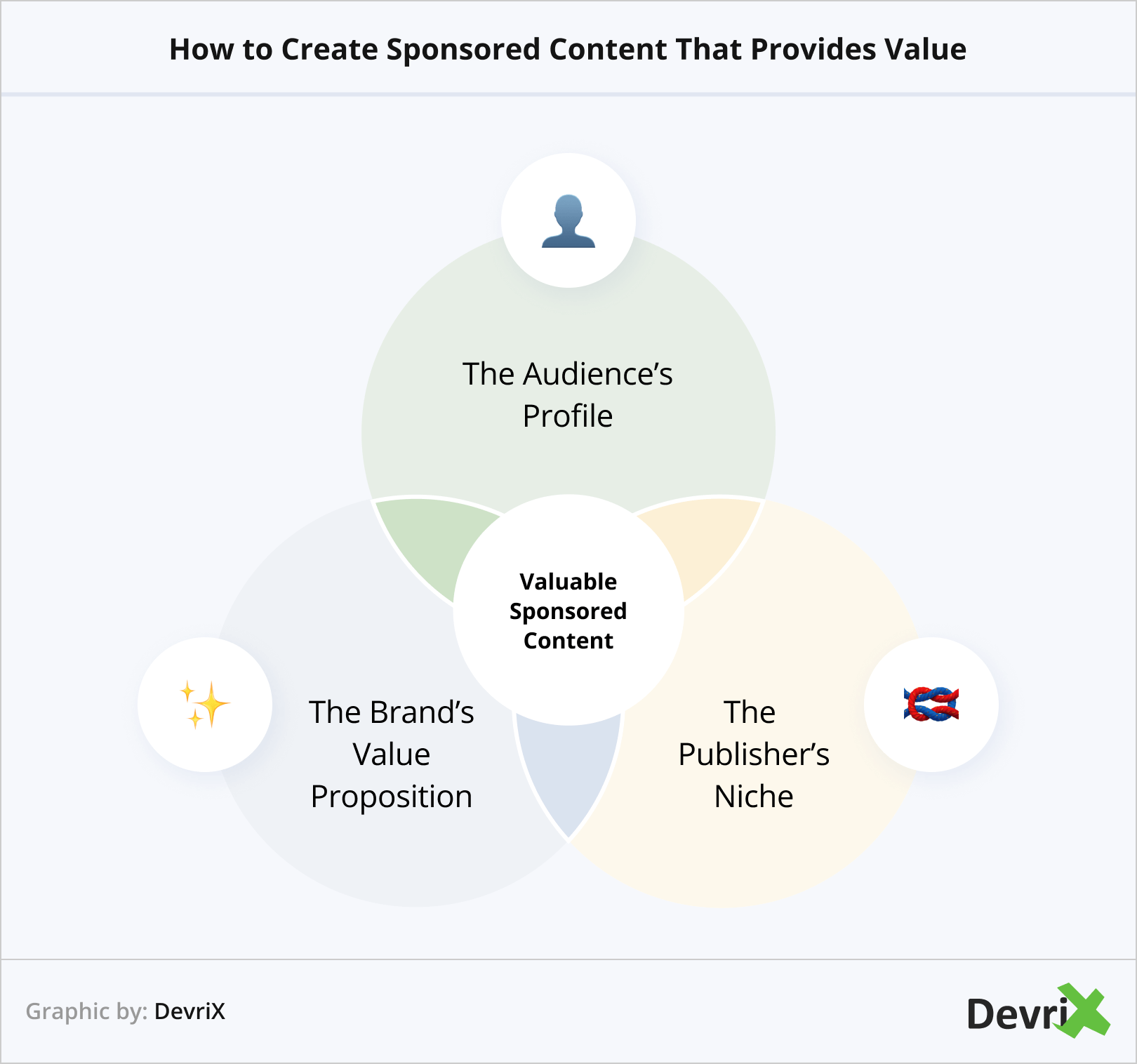Sponsored content has been an integral part of traditional marketing for quite a while and it’s not a surprise that digital marketing embraces it as well.
Today’s brands are starting to understand that the best way to expose the audience to their products and services is to build awareness in a natural way, without intruding into the customer’s personal space.
This becomes even more urgent with traditional direct advertising slowly but surely falling from grace.
At the same time, publishers want to populate their platforms with content and build revenue from different sources to ensure their stability.
And that’s exactly what sponsored content allows both sides to do.
However, if it’s not implemented properly, paid posts can not only annoy the audience and drive them away, but it can even lead to legal issues for the publisher.
In this article, we provide 6 tips on how to use sponsored content successfully on your website and benefit from it.
Read on and take notes!
What Is Sponsored Content
Sponsored content is a piece featured on a publisher’s platform – such as a website, social media profile, email, YouTube channel, etc. – that is paid for by a third party.
The difference between native advertising and sponsored content is that native ads are still ads. They may look, more or less, like the rest of the content on the platform. However, they are created by an advertiser with the aim to promote its products.
Sponsored content is created by the publisher and paid for by the advertiser.
In other words, native advertising produces ads that are disguised as content, and content sponsorship means funding a publisher in order to make your name known to their audience.
How to Properly Use Sponsored Content
Depending on the platform, how you present and format your content may differ. However, by following these 6 tips you can ensure that the end result will be pleasing to both your audience and the brand that you are partnering with.

How to Use Sponsored Content Without Annoying Your Audience
1. Mark the Content as Sponsored
2. Create Sponsored Content that Feels Native
3. Provide Value
4. Publish Only Relevant Pieces
5. Don’t Make It Feel Like Advertising
6. Stay in Line with the Official FTC Guidelines
1. Mark the Content as Sponsored
The first and foremost thing to remember when publishing sponsored content is to mark it as sponsored. This is entailed in the legal aspects that we will talk about later, but matters to your relationship with your audience as well.
Simply put, people need to know that the content is sponsored and who paid for it.
To ensure transparency, you need to label it as such not only on the page where it is hosted but also in any other place on your platform where the content is featured or linked to.
This way, when a person chooses to engage with the post, they will know what to expect.
People employ a different mindset when consuming regular content as opposed to promotional. And if they are not aware that the information is paid for by a third party, and find this out too late or by accident, they may feel cheated.
As a result, you will lose their trust and your credibility.
For example, it’s not a secret that many people tend to take influencer recommendations with a pinch of salt. That’s because, in the dawn of influencer marketing, these types of public figures were not always honest about why they are featuring a certain product in their posts.
When people found out that brands paid them for their good word, they felt their trust violated – the recommendation now felt less genuine.
Even though nowadays, influencers are bound by the law to inform their followers whether they are receiving some kind of remuneration for their services, people still mistrust them.
2. Create Sponsored Content that Feels Native
The second most important rule of sponsored content is to make it feel native to your platform. This way, even when visitors see that the piece is marked as sponsored, they are more likely to view and engage with it.
To that end, when creating sponsored content, make sure to retain the style, formatting, and overall feeling that is associated with the rest of your publications. As a result, the piece of content won’t stand out in a negative way and won’t feel outlandish.
This, of course, doesn’t mean that the brand that pays for the post can’t also be involved in the production. They can come up with the topic and provide suggestions on how their name is to be mentioned for the best impact.
However, to maintain consistency, the publisher needs to have the final say.
This also applies if the brand provides a snippet of content that they insist to be added. You need to retain the right to implement edits, strip it of the salesy parts, and make it feel native to your website.
As an alternative, if you feel that it doesn’t violate your principles, you can consider keeping it intact and adding it before or after the main content. Just make sure to format it differently and notify your audience that this part was provided by the sponsor and not created by you.
3. Provide Value
The best way to ensure that your audience enjoys the sponsored content that you publish and doesn’t feel annoyed by it is that it provides value. To that end, it needs to be relevant to their needs and interests, offer useful information, and/or help them solve a problem.
To be able to create such sponsored content, you need to look for the touch points between your audience’s profile, your publication’s niche, and the brand’s value proposition.

How to Create Sponsored Content That Provides Value
- The Audience’s Profile
- The Publisher’s Niche
- The Brand’s Value Proposition
However, the content doesn’t need (and really shouldn’t) focus on selling points.
The best campaigns empower users by educating them, supporting their values, and making them feel better about themselves.
They give them something without asking for anything in return.
Furthermore, as mentioned, people are always more critical when it comes to promotional content. To win them over, you need to put in the extra effort.
One way to do this, if you plan on publishing these types of pieces on a regular basis, is to develop and launch an original series of “powered by” content. This will not only shake your editorial calendar up, but can help your audience to better accept the paid post – it may even teach them to look forward to the new additions.
4. Publish Only Relevant Pieces
It goes without saying that the sponsored content needs to be relevant to what you normally publish. If it really belongs, it won’t seem out of place, and people are less likely to feel appalled by it.
To that end, you need to carefully choose the partners that you work with and how you approach the topics you collaborate on.
In other words, regardless of how great a sponsor reaches out to you with an offer, if you can’t think of ways that their product, services, and/or message can be related to yours, you should reconsider the partnership.
For example, if you are running a vegan cuisine blog, it won’t make sense to feature sponsored content from companies that don’t share the same values or are known for animal cruelty.
This will not only stand against your own ethics but will be offensive to your clients and will paint you as a sell-out.
The best way to avoid this is to think of sponsored content as a mutually beneficial partnership and a co-marketing opportunity. If your business and the brand you work with complement each other, your affiliation will result in providing unique value to the audience, and instead of annoying people, it may awe and inspire them.
Because it will make sense.
5. Don’t Make It Feel Like Advertising

The goal of sponsored content is not to highlight the assets of products but to build a connection with the audience and show them that they have something in common with the brand.
Whatever elements of advertising you try to sneak in, should be subtle, minimalistic, justified, and, preferably, kept somewhere at the end of the content.
However, it’s best to avoid direct advertising whatsoever. Including the name of the brand at the beginning and end of the piece, together with a note such as “sponsored by”, should be enough if there is interesting, engaging, and valuable content after.
Remember, the point is to build awareness and help the sponsor associate with positive things.
6. Stay in Line with the Official FTC Guidelines
As we mentioned above, in the early days of digital marketing and influencer recommendations, sponsored content was not regulated and inconsiderate brands and publishers kept abusing the audience’s trust.
As a result, the Federal Trade Commission (FTC) issued a set of Guidelines for Online Advertising and Marketing. These regulations aim to protect the audience and ensure the transparency of digital ads and sponsorship.
In a nutshell, to comply with the rules, you have to:
- Clearly state that the sponsored content is paid for by a third party.
- Mark the content as sponsored at all locations on your platforms where it is present.
- Provide information about the sponsor.
- Strictly avoid misleading the audience with false information.
However, keep in mind to carefully read the whole documentation on the FTC website to ensure that you meet all the requirements that apply to your particular case.
Bottom Line
Sponsored content can be beneficial for brands, publishers, and audiences alike.
However, to be successful, it needs to stray as far as possible from advertising and be nearly identical to the native content on the platform where it is published.
Furthermore, it needs to aim to bring value to the audience and focus on their existential interests, rather than their needs as consumers.
When brands and publishers embrace these types of partnerships as a way to strengthen their relationships with their followers, they can count on a deep and meaningful impact.




